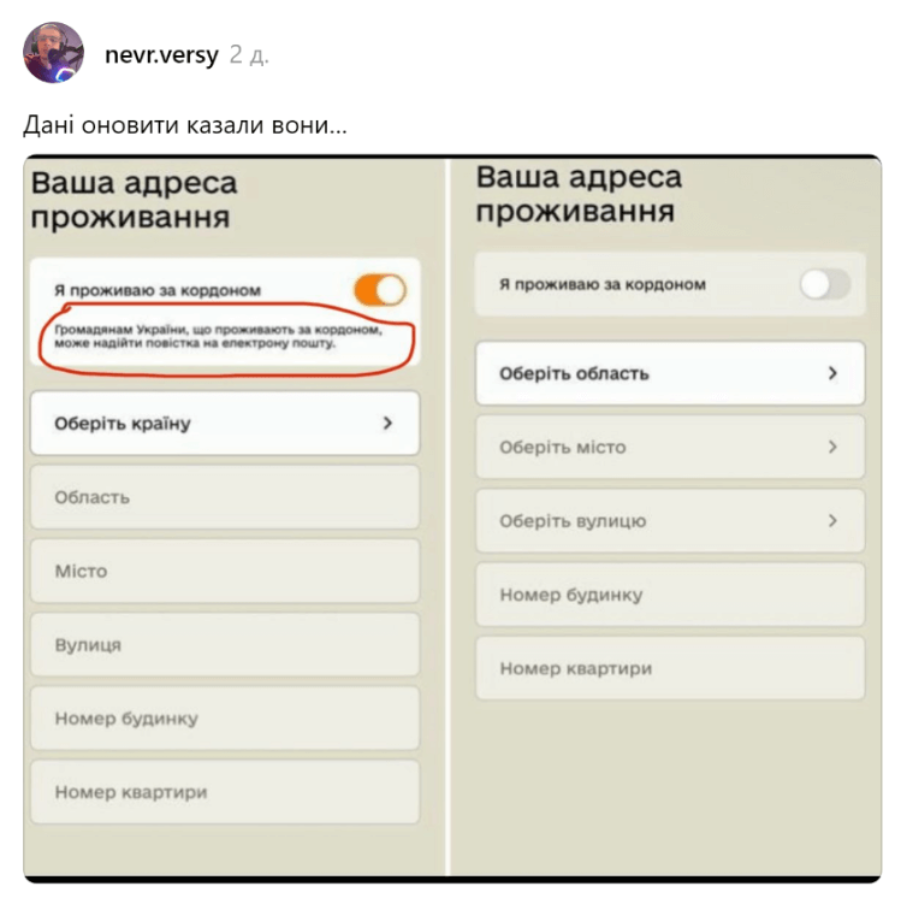The digitalization reform is accompanied by the spread of myths and conspiracy theories. Some arise due to a lack of information, while others are used as tools of manipulation. However, an analysis of the implementation of digital services reveals a different picture: they help reduce corruption risks and make the state’s work more transparent, while services for citizens become more accessible. Therefore, it is crucial to distinguish between real risks and imagined threats.
The digitalization reform involves the transfer of existing services and functions into digital formats, as well as the development of new digital tools to enhance economic efficiency, effectiveness, and the quality of interactions between the state, businesses, and citizens. In Ukraine, it has been ongoing for over a decade and remains among the reforms that Ukrainians consider the most beneficial for society.
Among the key factors accelerating the reform are improved internet access for the population, increased digital literacy among Ukrainians, and business initiatives aimed at developing new digital services. More and more people are using government online platforms, and companies are actively switching to electronic document management.
However, despite overall support, fears and prejudices remain a noticeable part of public discourse. One of the main reasons why Ukrainians do not use government online services is a lack of trust in electronic platforms. To a large extent, this is related to digital inequality, as some citizens still lack stable internet access or the necessary skills to use online services. A contributing factor is also the low awareness of user rights in the digital space — many people do not understand how their data is protected and how online services handle it. All this is exacerbated by psychological fatigue from constant online presence.
Low trust in state institutions slows down even the most successful digital solutions, as citizens doubt the protection of their personal data. These concerns are heightened during wartime, when unstable power supply and increasing cyber threats cast doubt on the reliability of online services. Additionally, the rapid development of AI raises concerns about the potential for information manipulation.
Such concerns are not unique to Ukrainians. Alongside the global spread of digital technologies, concerns related to data security, privacy, surveillance, and the loss of control over personal information are increasing. For instance, while most Europeans (73%) acknowledge that digital services make life easier, many fear misuse of personal data (46%) and disinformation (45%). The level of trust directly depends on the feeling of security: 79% of Europeans are convinced that better data protection would make online services more convenient, and 39% say it would encourage them to use digital tools more often. Similar sentiments exist in the United States, where most citizens are concerned about how businesses and the state use their personal data — especially information about children.
These considerations directly influence the pace of digital transformation: the higher the level of trust in technology, the more actively businesses implement digital solutions, and the more the state develops data-based services. In contrast, unaddressed risks, frequent technical failures, or cases of fraud reduce trust in digitalization. Yet, not only real threats but also imagined ones can slow development.
Technophobic Theories vs Digitalization
Fears surrounding the introduction of new technologies are not exclusively a Ukrainian phenomenon. For example, in the United Kingdom, fake news was spread claiming that the 5G network transmits COVID-19. It was also stated that this type of connection allegedly weakens the immune system, making people more vulnerable to infection by the virus.
Ukraine was not spared from this conspiracy theory either: users of the Ukrainian segment of social media spread myths about the critical harm of 5G to health. However, the WHO reports that no adverse effects from exposure to 5G signals on the human body have been recorded. Researchers classify this type of connection (like any other currently in use) as safe.
In addition to general trends, Ukraine has its own local context related to the development of domestic digitalization products — specifically, their security and allegedly hidden purposes.
For instance, fake screenshots of the Reserve+ app were circulated on social media, allegedly showing that citizens abroad would receive draft notices by email. In fact, the app contains no such notification — it only informs that the Territorial Recruitment and Social Support Centers may contact Ukrainian citizens abroad by email to update their data. The fake screenshots show obvious signs of editing, including a different font color. 
Fake screenshot from the Reserve+ app

Screenshot from the data entry page in the Reserve+ app
This is a clear example of how an insufficient understanding of digital service functions and concerns for personal safety are used to disseminate blatantly false information.
Another “pillar” of the future “digital concentration camp”, according to social media users, is the complete digitalization of finances. For example, information was circulated online claiming that Ukraine would soon ban the use of cash. This, allegedly, proves that Ukraine is a “social laboratory” where experiments are conducted that other governments wish to implement.
Conspiracy theorists often refer to “global conspiracies” of international organizations supposedly demanding such innovations. For instance, they spread the claim that the World Economic Forum allegedly called on governments to urgently abolish cash and introduce a “Chinese-style” social credit system. In reality, the WEF merely published an analytical report on the development of digital currencies worldwide — without any calls or demands.
In Ukraine, cash has not been banned — there was only a discussion about the possibility of a gradual transition to a cashless economy, not a finalized decision. The National Bank of Ukraine stated that a complete rejection of cash is impossible during wartime, as citizens must have access to money in the event of emergencies, such as power outages.
Such fakes arise from misunderstanding: public discussion of potential reforms does not mean their immediate implementation. Any changes to the financial system undergo several stages — from analysis and pilot testing to legislative decisions and broad implementation. Therefore, when a new idea appears in the information space, it means the beginning of a discussion about its feasibility, not that it will be launched “tomorrow”.
One of the components of developing digitalization in public services is education. The topic of protecting children’s personal data is particularly sensitive, so many myths have appeared around the Mriia app.
For example, information was circulated on social media claiming that Mriia determines the “life priority” of Ukrainian children and turns them into objects of digital control. However, these are baseless fabrications. Mriia does not collect any sensitive information about children that the state did not already have — the app only accesses data such as name, date of birth, or taxpayer card number. All this information already exists in state registers.
Conspiracy theorists insist that the app will dictate how parents communicate with their children. Allegedly, it will “take” children away from their parents and turn them into “biorobots”. However, after the app’s launch and usage, it became clear that it does not regulate communication between parents and children in any way. Mriia only provides a way for teachers and parents to communicate within the app: teachers maintain a journal with grades, attendance, and study plans, while parents can monitor their children’s grades, attendance, and homework. Thus, once again, the alarming claims proved to be false.
When Technologies Become a Tool of Deception
The fear of digitalization often arises from users’ own negative experiences. For example, a person may try to use a digital service but fail to get the expected result due to technical malfunctions or other issues. As a result, the user begins to perceive digital services as useless or risky and refuses to use them.
A more serious concern is fraud. Often, scammers disguise themselves as providers of digital services to steal money or personal data. According to surveys, in Ukraine, 11.1% of adults have suffered financial losses due to theft, fraudulent messages, or fake websites. Among teenagers, a similar figure is 10.9%. Additionally, 6.6% of the adults surveyed reported falling victim to social media account hacking. Among teenagers, this figure is 14.8%.
We have repeatedly documented examples of such schemes, often related to the topics of war and social welfare — because, against the backdrop of fear and uncertainty, such tactics become most effective.
For example, since 2022, information has spread online claiming that every Ukrainian could receive compensation through the “Unified Compensation Center for the Return of Unpaid Funds”, which supposedly operated through the eDopomoha platform in partnership with the Ministry of Social Policy. But such a payment never existed, and there is no such center in Ukraine. Later, scammers promised payments of UAH 6,500 under the ePidtrymka program and a subsidy of UAH 7,300 to cover expenses during power outages. They also created Telegram chatbots that copied the visual identity of the official Diia chatbot but had different names and descriptions.
In all cases, fraudulent websites mimicked government programs and used links to steal personal data. Where that was not the goal, they sought to boost subscriptions to anonymous Telegram channels that spread unverified news — a flow that also undermines trust in electronic tools, especially among older people.
Digitalization — Unprofitable?
Another myth about wartime digitalization is that it is allegedly too expensive and burdens the budget and businesses. It is often said that electronic services or online procurement are luxuries during wartime. However, on the contrary, digital solutions help save money and time.
For example, in the field of procurement, there is a common myth that electronic platforms are too costly. In fact, contracting authorities can post tenders for free, and suppliers only pay to participate. There are even packages that allow participation in tenders without paying for each procedure.
Some Ukrainians do not use digital services because they fear they are too complicated or require additional steps. This is often due to low levels of digital skills and the fact that communication about new government services does not reach all users: people are unaware of how the service works or the opportunities it provides. Because of this, fake news that distorts reality spreads easily.
For example, claims circulated online that to exchange an old driver’s license for a new one, it was necessary to retake the driving test. In fact, according to a Cabinet of Ministers resolution, a driver’s license can be exchanged without taking any exams.
Another widespread fake claim stated that if a driver is registered in a temporarily occupied city and loses their license, it is impossible to obtain a new one. However, the same Cabinet of Ministers resolution clearly states that license exchange is carried out regardless of the registered place of residence.
The spread of such myths creates the impression that online services are complicated or inaccessible, causing people to continue turning to Administrative Service Centers (CNAPs), even when the same certificate can be obtained online in just a few clicks. As a result, part of the population perceives digitalization as redundant bureaucracy. In fact, it was created precisely to reduce it — to simplify access to government services, not complicate it.
Digitalization is developing under the conditions of full-scale war, which naturally entails increased attention to issues of security and privacy. Some public concerns are amplified by technical failures, fraudulent schemes, or isolated hacking incidents, which create a sense of vulnerability of the digital infrastructure. Despite this, digital services have already proven their effectiveness in crisis conditions — they have simplified access to government services and ensured the continuity of administrative processes even during wartime.
To reduce the level of distrust toward the digitalization reform, it is necessary to systematically strengthen cybersecurity, increase users’ digital literacy, and maintain regular communication about service functionalities, their limitations, and principles of personal data processing. Openness, predictability, and clear rules of interaction with digital systems should become key factors in building public confidence in the digital state’s safety.
In communication, it is essential to shift the focus from the technical characteristics of services to the user experience, emphasizing specific, widely understandable advantages such as time savings. Digital tools should be perceived not as an obligatory or controlling mechanism but as instruments for improving convenience and efficiency. Such messages will help form an understanding that digitalization is not an additional burden but a way to reduce stress and simplify everyday interactions with the state.
The report is produced by NGO Vox Ukraine with the support of the Askold and Dir Fund as a part of the the Strong Civil Society of Ukraine – a Driver towards Reforms and Democracy project, implemented by ISAR Ednannia, funded by Norway and Sweden. The contents of this publication are the sole responsibility of NGO Vox Ukraine and can in no way be taken to reflect the views of the Government of Norway, the Government of Sweden and ISAR Ednannia.

Attention
The authors do not work for, consult to, own shares in or receive funding from any company or organization that would benefit from this article, and have no relevant affiliations



